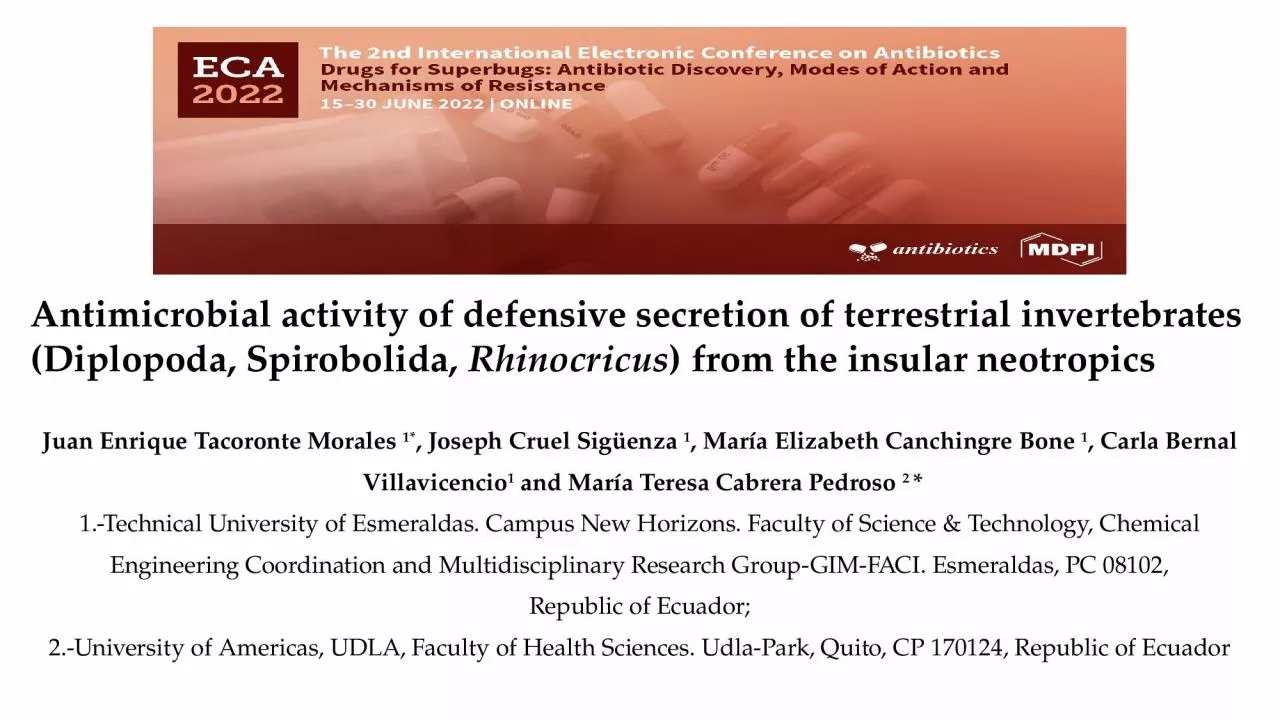

Spirobolida Rhinocricus from the insular neotropics Juan Enrique Tacoronte Morales 1 Joseph Cruel Sigüenza 1 María Elizabeth Canchingre Bone 1 Carla Bernal Villavicencio ID: 1026691
Download Presentation The PPT/PDF document "Antimicrobial activity of defensive secr..." is the property of its rightful owner. Permission is granted to download and print the materials on this web site for personal, non-commercial use only, and to display it on your personal computer provided you do not modify the materials and that you retain all copyright notices contained in the materials. By downloading content from our website, you accept the terms of this agreement.
1. Antimicrobial activity of defensive secretion of terrestrial invertebrates (Diplopoda, Spirobolida, Rhinocricus) from the insular neotropics Juan Enrique Tacoronte Morales 1*, Joseph Cruel Sigüenza 1, María Elizabeth Canchingre Bone 1, Carla Bernal Villavicencio1 and María Teresa Cabrera Pedroso 2 *1.-Technical University of Esmeraldas. Campus New Horizons. Faculty of Science & Technology, Chemical Engineering Coordination and Multidisciplinary Research Group-GIM-FACI. Esmeraldas, PC 08102, Republic of Ecuador;2.-University of Americas, UDLA, Faculty of Health Sciences. Udla-Park, Quito, CP 170124, Republic of Ecuador
2. In the last 30 years, a significant increase in resistance of pathogenic microorganisms to conventional therapeutic strategies has been observed and it constitutes a drive force for the search of, in plants and microorganisms, more effective bioactive molecular systems. In this context, terrestrial invertebrates associated with mega edapho-fauna has not been considered as a source of poly-component systems or molecular entities with potential antimicrobial action. The defensive secretions of Diplopods, given the presence of benzenoids and monoterpenes, possess recognized antimicrobial activity. In the present communication we report the isolation of repugnatorial secretions from millipedes gen. Rhinocricus inhabiting in Cuban neotropical island conditions and the analysis, by GC/Ms, of their composition pattern (hydroxylated quinonoids) that show, under in vitro conditions, a significative antimicrobial activity against pathogenic microorganisms (Candida albicans, E.coli and S.aureus). These natural derivatives can be used, as bioactive components, in formulations for topical treatment of epidermal infections of microbial origin.Keywords: Diplopoda, Rhinocricus, defensive secretions, antimicrobial activity.
3. General protocols for defensive repugnatorial secretion analysis
4. Defensive secretion isolated1.-methanol2.-dry with N2 /-10 0C 3.-CH2Cl2 / GC-MS /2μLStructural elucidationComposition patterns FTIR, NMR, GC-MSBio-screening: MIC; MBC; MFCStaphylococcus aureus subsp. Aureus (ATCC 6538)Escherichia coli (ATCC 8739)Pseudomonas aeruginosa (ATCC 9027)Candida albicans (ATCC 10231)Formulation designGreen synthesis of major componentsOther potential targetsand biological activity testsAtta, Aedes, Aphids, HemipteraPreparation of new Derivatives Via eco-sustainable synthetic protocolsRhinocricus spBanao, Cuba
5.
6. Antibacterial activity of defensive secretion of Rhinocricus sp from Banao Forest, Cuba. Antifungal activity of defensive secretion of Rhinocricus sp from Banao Forest, CubaTaxaC. albicans (nL/mL)Rhinocricus sp.(Diplopoda, Spirobolida)Banao Forest(-79.5686 W; 21.8286 N)Cuban archipelagoMIC*MFC*> 4000,5> 4000,5
7. The results presented in this study demonstrate that the complex poly-component mixture of benzoquinonoids (p-benzoquinones substituted and hydroquinones + and primary alkylaromatic amine) presents in the defensive secretion of Rhinocricus sp possess a potent antimicrobial activity for both Gram positive and negative bacteria and fungi. In general, the secreted repugnatorial fluid from ozopores of Rhinocricus sp showed a more pronounced toxicity against the Gram-positive bacterium S. aureus, which was completely eliminated with a concentration of the defensive secretion in the order of parts per million (ppm). It is considered that most species with a quinonic-hydroquinone chemoprofile live in the soil and litter, where they are in direct contact with many pathogenic microorganisms and MIC values for benzoquinones are low and very effective at deterring microorganismsThis study represents the first report devoted the antimicrobial activity of defensive secretions isolated from Rhinocricus sp, inhabiting in Banao Forest located in the central eco-region of the Cuban neotropical archipelago. In general, the tested extract showed antimicrobial activity against both type of bacteria. The defensive secretion also exhibited an antifungal potential. The given extract contains antimicrobial components potentially useful as therapeutic agents in the pharmaceutical and agricultural industries.
8. Author Contributions: Conceptualization, J.E.T.M. and CBV.; methodology, MTCP, JETM.; formal analysis, MECB; investigation, JETM, MECB, CBV, MTCP; resources, JCS; data curation, JCS, JETM; writing—original draft preparation, MTCP; writing—review and editing, JETM, MECB; supervision, CBV; project administration, JCS; funding acquisition, JCS. All authors have read and agreed to the published version of the manuscript.Tacoronte, J.; Tchervas, T.; Prieto, D.; Rodríguez, C.; Aspiazu, M.; Gonzalez, V. A natural benzoquinone isolated from defensive secretions of Cuban endemic millipede. Rev. CNIC. Cienc. Quím. (Chem. Sci.) 2005, 36, 115–116.Tacoronte, J.; Cabrera Pedroso, M.T. Defensive secretions of terrestrial invertebrates. Applied Chemical Ecology. A molecular and Eco sustainable perspective of the Ecuadorian biodiversity. In Un Espacio para la Ciencia; Manglar: Quito, Ecuador, 2018; Vol. 1, Ch.2, 51–100.Mesa, J.A.; Tacoronte, J.; Montes de Oca, R.; Tobellas, J.; Garrido, R. 3,4-dimethoxyphenol, in defensive secretions of Cuban endemic millipedes (Spirobolida, Rhinocricidae, Rhinocricus). A study case Rhinocricus duvernoyi Karch 1881, geographical population of La Palma. Rev. CENIC Cienc. Quím. (Chem.Sci.) 2009, 40, 32–35.Morales, J.E.T.; Cabrera, M.T. Diplodomica II. Repugnatorial Secretion of Ecuadorian Endemic Millipede Rhinocricus sp. (Diplopoda, Spirobolida, Rhinocricidae) from Orellana Province, Amazonia, Ecuador. Chem. Proc. 2021, 3, 90-97. https://doi.org/10.3390/ecsoc-24-08435.Morales, J.E.T.; Pedroso, M.T.C. Diplodomica I. Chemical Composition of Repugnatorial Secretions of Cuban Endemic Millipede gen. Rhinocricus sp. Proceedings 2019, 41, 73-79. https://doi.org/10.3390/ecsoc-23-06522.